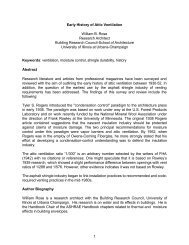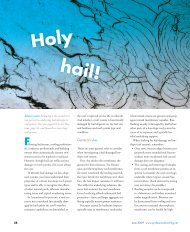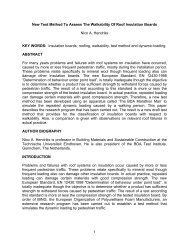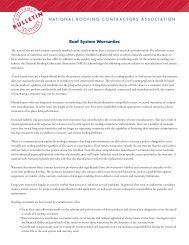Untitled - National Roofing Contractors Association
Untitled - National Roofing Contractors Association
Untitled - National Roofing Contractors Association
You also want an ePaper? Increase the reach of your titles
YUMPU automatically turns print PDFs into web optimized ePapers that Google loves.
ane wherever possible to prevent metal movements<br />
from splitting the membrane. Aashing details<br />
that require metal flanges to be sandwiched into the<br />
roof membrane should be avoided if possible.<br />
For all walls and protections that receive composition<br />
base flashing, metal counterflashing should be<br />
installed in the wall above the base flashing. The design<br />
of this detail should be two-piece, allowing installation<br />
of the counterflashing after the base flashing.<br />
Single-piece installations cannot be flashed<br />
properly nor can reroofing and roofing maintenance<br />
be performed without deforming the metal. Sheet<br />
metal should NEVER be used as a base flashing.<br />
Metal wall cap flashing is often used to cover the top<br />
of a wall in lieu of masonry copings. In most cases<br />
the metal counterflashing is attached to the inside<br />
face of the metal wall cap flashing with sheet metal<br />
screws.<br />
Gravel stops should be raised above the waterline<br />
by using tapered cants and wood blocking. When<br />
this is not possible, the metal flanges for low-profile<br />
gravel stops should be set in mastic on top of the<br />
completed roof membrane and nailed at close intervals<br />
to the wood nailer. The metal flange should then<br />
be primed with asphalt primer and felt flashing strips<br />
applied. Interior drainage is recommended, and<br />
edges should be raised whenever possible. A metal<br />
edging should NEVER be used as a water dam or<br />
waterstop. The practice of connecting sheet metal<br />
to the roof membrane should be avoided<br />
whenever possible. Pipe projections through the<br />
membrane require metal flashing or the insertion of<br />
roof jacks into the membrane. Metal flanges should<br />
be set in mastic over the completed membrane and<br />
primed and stripped in with flashing strips.<br />
XXIII. SURFACING AND AGGREGATE<br />
Most roof membranes, if not presurfaced, require some<br />
type of wearing surface. This surfacing should be applied<br />
as soon as it is practical after the membrane is installed.<br />
Gravel, slag, marble chips, etc. are the aggregates<br />
used for aggregate-surfaced roofs. Asphalt and<br />
liquid surface coatings are used on some smoothsurfaced<br />
roofs.<br />
Gravel or aggregate surfacing should be set in hot bitumen,<br />
either by a bitumen dispenser or by hand pouring.<br />
Gravel placed by machine will result in somewhat lighter<br />
surface bitumen poundages in some locations since<br />
the gravel, as it flows from the gravelling machine, tends<br />
to create a "wave" effect in the hot bitumen as it is<br />
placed.<br />
Hand pouring produces heavier poundages but less uniform<br />
coverage, but neither method is preferable to the<br />
other. Gravel or other aggregate should be fairly rounded<br />
in shape and should contain a minimum of flat, sharp<br />
or elongated particles. At the time of application, the aggregate<br />
should be hard, durable, opaque, surface dry<br />
and free of clay, loam, sand or other foreign substances.<br />
Storage piles of aggregate should be placed on coated<br />
or gravelled portions of the membrane and not on bare<br />
felt. Occasionally, on well-applied roofs, small black globules<br />
known as "raspberries" or "blackberries" will form<br />
in the roof surface. These are not detrimental to the roof<br />
and simply indicate that large quantities of bitumen flood<br />
coat were applied and have bubbled up around the aggregate.<br />
To avoid excessive aggregate loss, aggregate<br />
surfacing should not be applied to roofs whose slope is<br />
greater than 3 inches per foot.<br />
Generally, smooth-surfaced coatings should be applied<br />
as soon as possible after the membrane is installed.<br />
Some coatings, however, must be applied over a previously<br />
applied thin coating of hot asphalt. The manufacturer's<br />
instructions should be consulted to determine if<br />
this thin coating is required. If it is, that asphalt should<br />
be allowed to "age" (or oxidize) for a period of two to four<br />
38 39





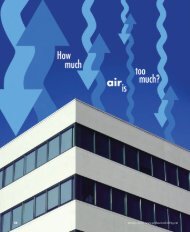

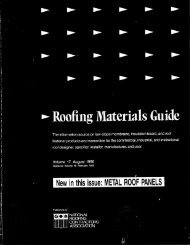
![Wm] - National Roofing Contractors Association](https://img.yumpu.com/36696816/1/190x245/wm-national-roofing-contractors-association.jpg?quality=85)


